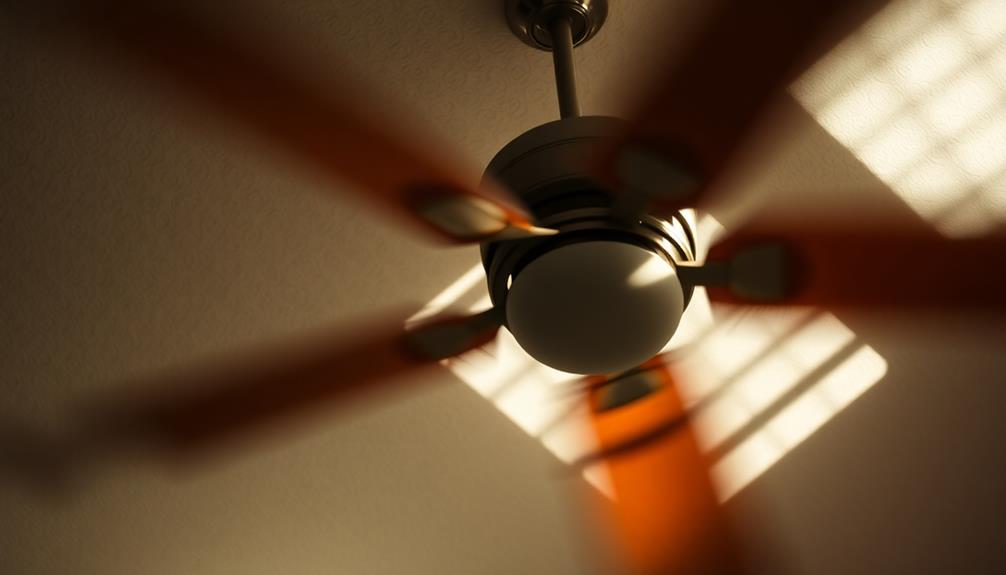Revealing the secrets of ceiling fan RPM lets you fine-tune your home's airflow for maximum comfort. RPM, or revolutions per minute, directly affects the strength of the breeze. Higher RPMs mean more cooling, but they can lead to increased energy costs. You can optimize settings based on room size: 1000-2000 RPM for small spaces and 3000-5000 for large ones. Measuring RPM is easy with a tachometer or smartphone app, ensuring you find the right balance. Regular maintenance enhances performance and prevents issues. Keep exploring to discover tips for energy efficiency and safety as well.
Key Takeaways
- RPM, or revolutions per minute, determines the airflow strength of a ceiling fan, influencing comfort levels in a room.
- Different RPM ranges provide varying airflow effects, with 1000-1500 RPM offering a gentle breeze and over 3500 RPM delivering powerful air movement.
- Small rooms require 1000-2000 RPM, while larger spaces may need 3000-5000 RPM for optimal comfort and energy efficiency.
- Regular maintenance, like cleaning blades and checking motor function, ensures consistent RPM and prevents decreased performance over time.
- Variable speed controls allow users to adjust RPM, balancing comfort with energy savings effectively.
What Is Ceiling Fan RPM?
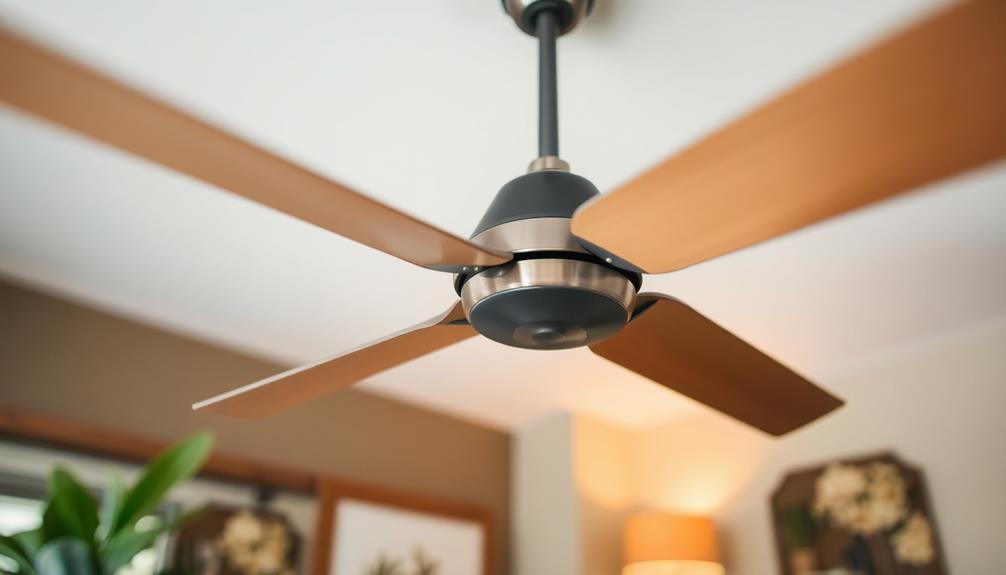
Understanding ceiling fan RPM is essential for optimizing your comfort and energy efficiency. RPM, or revolutions per minute, measures how many full rotations the fan blades complete in one minute. A higher RPM means stronger airflow, which can greatly enhance your cooling experience.
The motor speed directly affects RPM; if it's not functioning properly, you might notice your fan isn't providing enough breeze. By identifying the RPM, you can troubleshoot issues like slow operation, which could stem from improper installation or motor problems.
Manufacturers often use tachometers for accurate RPM measurement. Keep in mind that higher RPMs can lead to increased noise, so finding the right balance is key for a comfortable environment without excessive sound.
Why RPM Matters
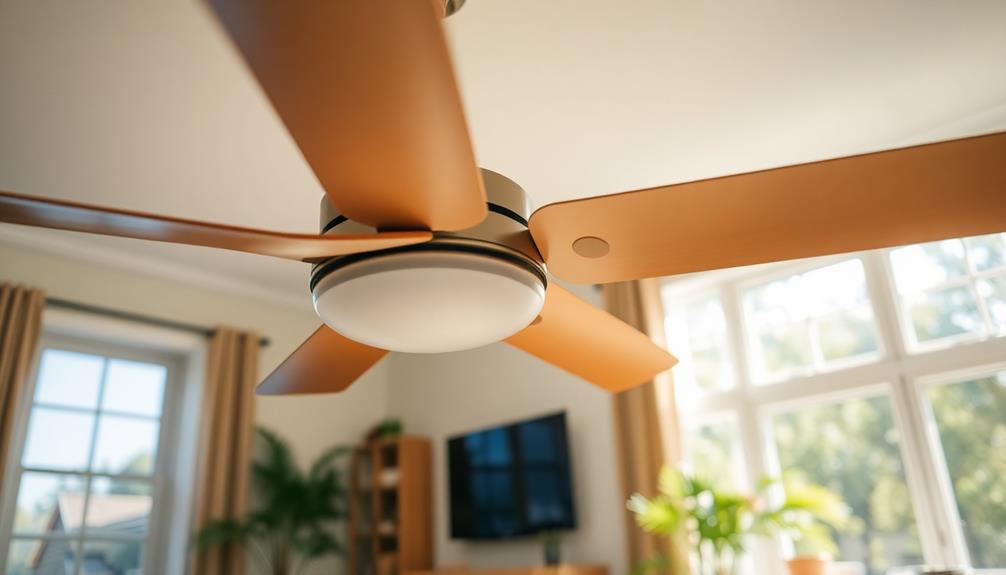
Ceiling fan RPM plays a crucial role in your overall comfort and energy efficiency. The speed at which your fan operates determines how much airflow you receive, directly impacting how cool or warm you feel. A fan running too slowly can leave you feeling hot, while one running too fast might crank up your energy bills unnecessarily.
| RPM Range | Effect |
|---|---|
| 1000-1500 RPM | Gentle breeze |
| 1500-2500 RPM | Comfortable airflow |
| 2500-3500 RPM | Strong ventilation |
| 3500+ RPM | Powerful air movement |
Understanding and adjusting your fan's RPM helps you balance comfort and energy use, making it indispensable for an efficient living space.
RPM Guidelines by Room Size
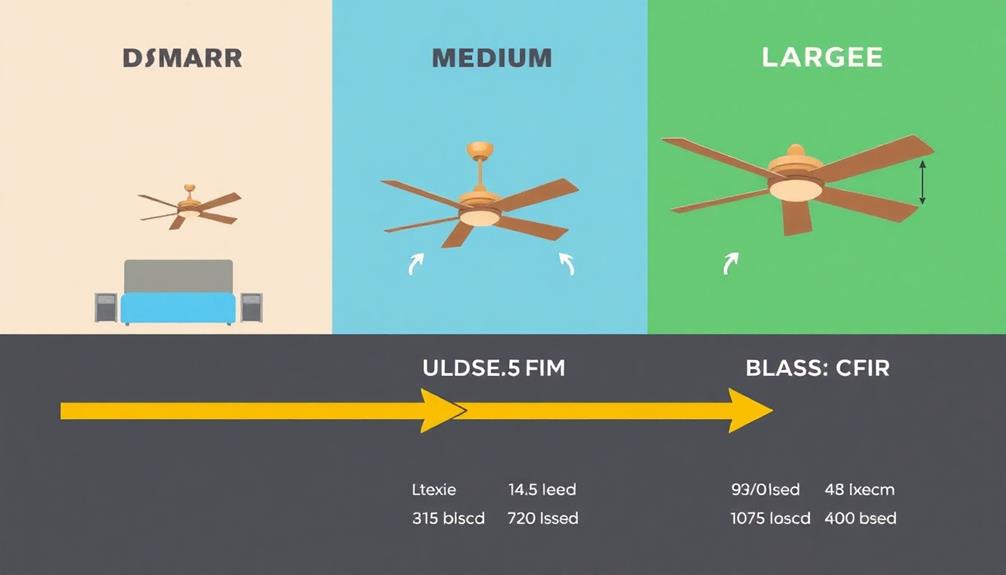
When selecting the right RPM for your ceiling fan, room size plays a pivotal role in achieving ideal comfort and efficiency.
For small rooms up to 75 sq. ft., aim for 1000-2000 RPM.
In medium rooms measuring 76-144 sq. ft., target 1500-3000 RPM.
If your space is large, between 145-225 sq. ft., you should set your fan to 2000-4000 RPM.
For extra-large rooms over 226 sq. ft., adjust the RPM to 3000-5000.
These guidelines help guarantee you get the right airflow without wasting energy.
Measuring Ceiling Fan RPM
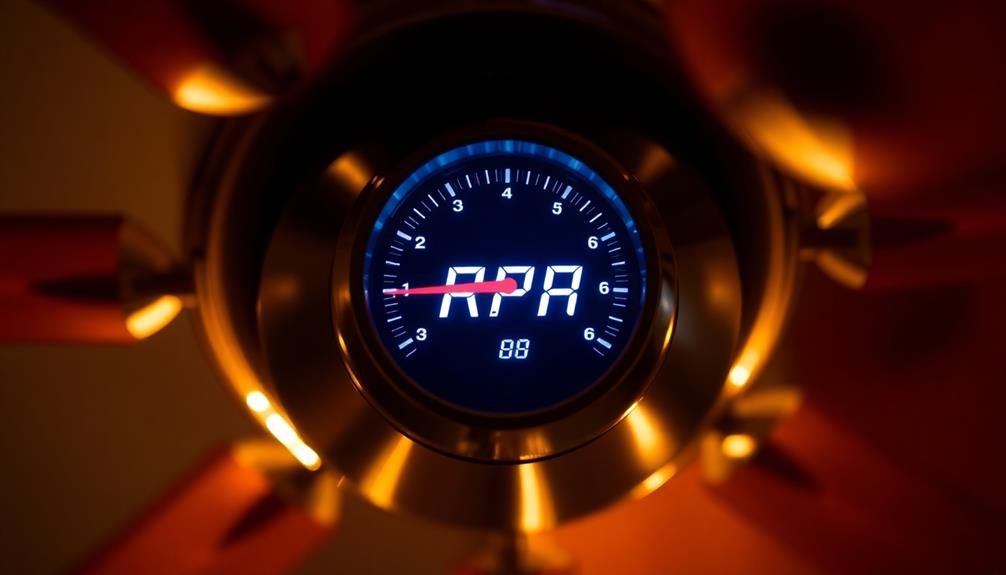
To accurately measure your ceiling fan's RPM, you'll need the right tools and a bit of technique. Start by gathering a tachometer or a reliable smartphone app.
Here's how to get it right:
- Identify a visible fan blade for tracking.
- Mark a reference point on the wall directly below the blade.
- Count the number of rotations in one minute.
- Divide by the time in minutes if you're using a stopwatch.
- Repeat a few times for consistency.
This method guarantees you understand your fan's performance. Knowing the RPM helps you adjust settings for ideal comfort and airflow.
With these steps, you'll confidently measure your ceiling fan's efficiency and make informed decisions for your space.
Energy Efficiency Insights
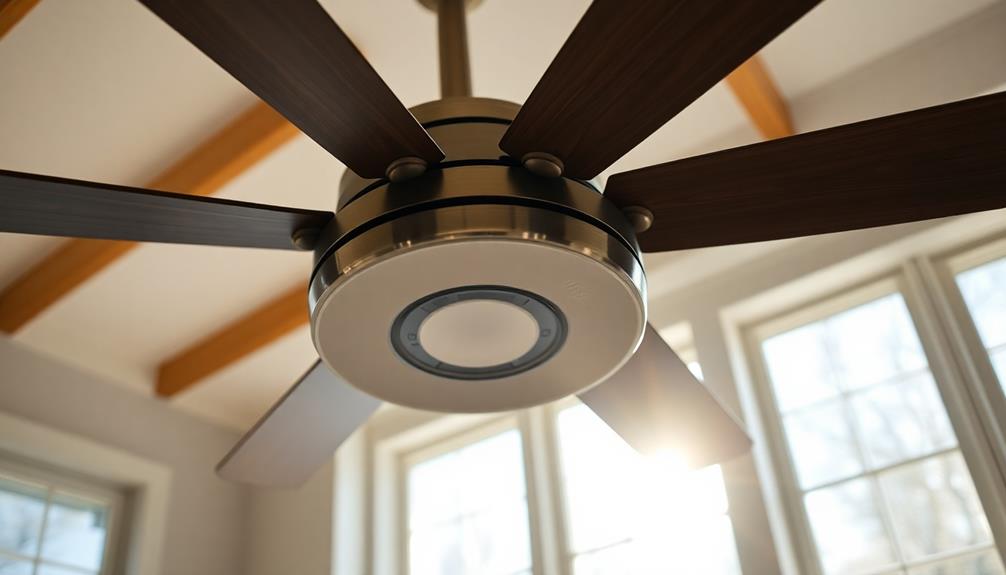
Energy efficiency is an essential consideration for maximizing the performance of your ceiling fan. Higher RPM fans often consume more energy, leading to increased electricity bills.
By using variable speed controls, you can adjust RPM settings to find the sweet spot that balances comfort and energy savings. Running your fan at lower RPMs not only reduces energy usage but also helps maintain a comfortable environment.
Additionally, choosing a fan with an efficient motor design can further contribute to overall savings. Remember, while higher RPM might boost airflow, it can also create more noise and strain the motor.
Always consult the manufacturer's guidelines for ideal settings based on your room size to guarantee you're getting the best performance without excessive energy consumption.
Safety Considerations
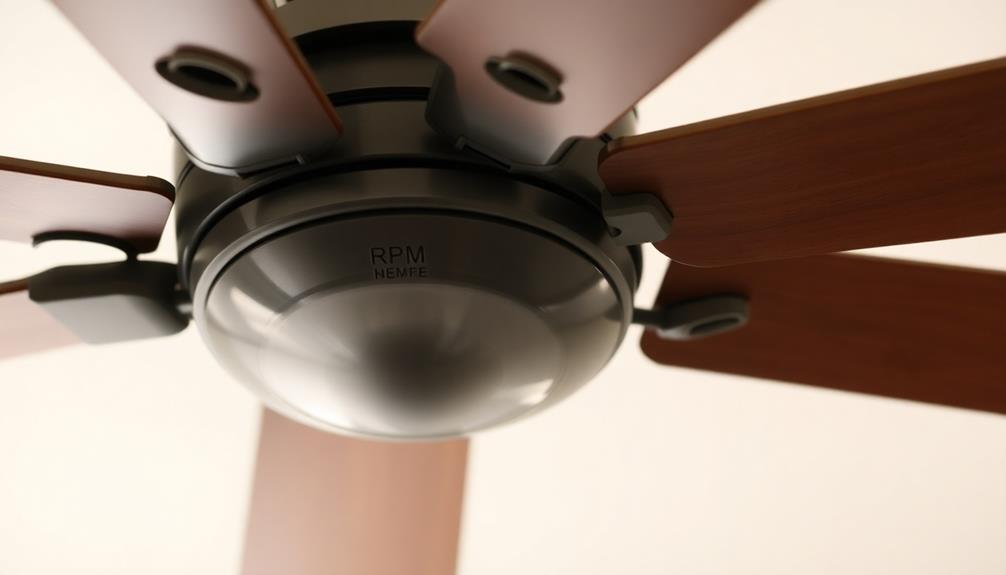
Safety should always be a top priority with ceiling fans. High RPM fans can cause excessive vibration, risking stability and safety in your home. Strong air currents might pose hazards to nearby objects and people, so it's vital to follow regulations guaranteeing fans operate within safe limits.
Here are some important safety tips to keep in mind:
- Secure installation: Confirm your fan is properly mounted and stable.
- Clear surroundings: Keep furniture and decor clear of the fan's path.
- Regular maintenance: Clean dust and debris to prevent imbalance.
- Child and pet safety: Keep kids and pets away from the fan when in operation.
- Monitor noise: If your fan becomes unusually noisy, it may need inspection.
Maintenance Tips for Optimal Performance
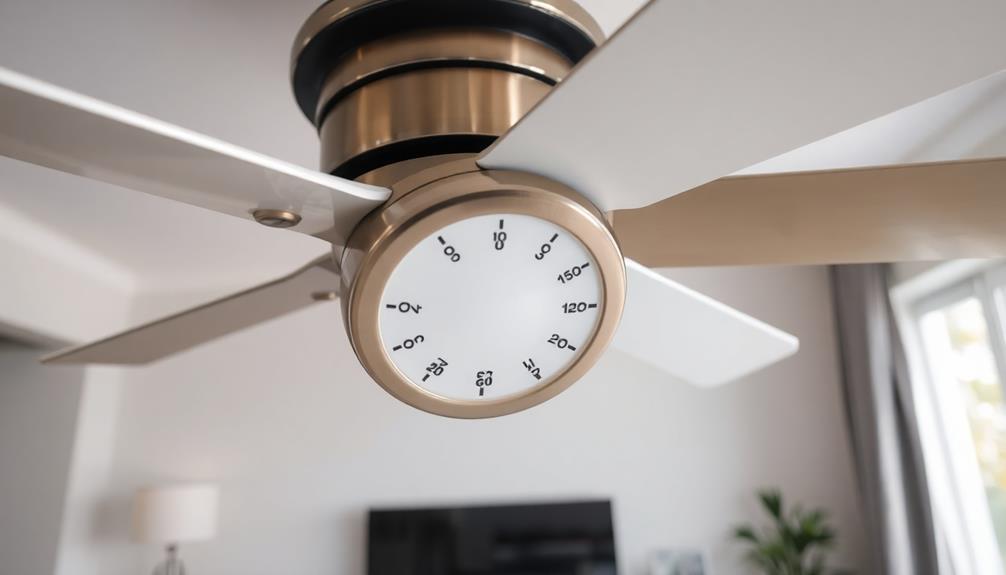
Maintaining your ceiling fan is key to ensuring peak performance and longevity. Start by regularly cleaning the blades to prevent dust buildup, which can hinder airflow. Use a damp cloth for quick wipe-downs, and consider a mild cleaner for tougher grime.
It's important to remember that just as with heat pumps, inadequate maintenance can lead to decreased efficiency over time. Check that screws and blades are tight, as loose components can lead to noise and vibration.
Adjust the speed settings based on the season: run the fan counterclockwise in summer for a cooling breeze and clockwise in winter to circulate warm air. Inspect the motor and wiring for any signs of wear.
Frequently Asked Questions
Can I Adjust My Ceiling Fan's RPM Manually?
Yes, you can adjust your ceiling fan's RPM manually if it has a variable speed control or pull chain. Simply change the speed setting to achieve the airflow level that suits your comfort needs.
What Types of Motors Are Used in Ceiling Fans?
Most ceiling fans use either shaded pole or permanent split capacitor motors. These motors can run at a steady RPM, giving you the comfort of a consistent breeze without unnecessary energy consumption or noise. These motor types are also durable and require minimal maintenance, making them a reliable choice for long-term use. Additionally, many modern ceiling fans incorporate smart features, enhancing convenience and efficiency. One of the key benefits of remote ceiling fans is the ability to adjust speed, direction, and even lighting from the comfort of your couch or bed, offering unparalleled ease of operation.
How Does Blade Shape Affect Ceiling Fan RPM?
Blade shape greatly impacts your ceiling fan's RPM. If blades are wider or angled, they can create more airflow at lower speeds, enhancing efficiency. Adjusting blade shape aligns with your comfort needs and energy-saving goals.
Are There Ceiling Fans Designed Specifically for Outdoor Use?
Awesome outdoor fans are designed to withstand weather's whims. You'll enjoy breezy bliss with these sturdy models, ensuring perfect performance and prolonged pleasure in your patio or porch, regardless of rain or shine.
How Often Should I Replace My Ceiling Fan?
You should replace your ceiling fan every 10 to 15 years, or if you notice excessive noise, wobbling, or reduced airflow. Regular maintenance can prolong its life, but signs of wear indicate it's time for a replacement.
Conclusion
Now that you've unraveled the mysteries of ceiling fan RPM, you're ready to turn your living space into a breezy oasis. By mastering the art of airflow, you'll dance through summer heat without breaking the bank. Remember, a well-chosen RPM is like a gentle whisper of wind, keeping you cool and comfortable. So, go ahead and embrace these tips, ensuring your fan spins smoothly, like a well-tuned symphony, bringing you year-round comfort and energy savings.
